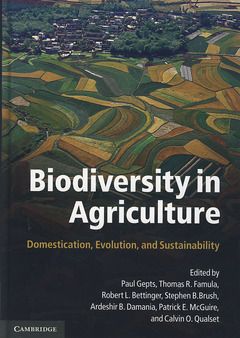List of contributors; Foreword Bruce D. Smith; Acknowledgments; Introduction. The domestication of plants and animals: ten unanswered questions Paul Gepts, Robert Bettinger, Stephen Brush, Ardeshir Damania, Thomas Famula, Patrick McGuire and Calvin Qualset; 1. The local origins of domestication Jared Diamond; Part I. Early Steps in Agricultural Domestication: 2. Evolution of agro-ecosystems: biodiversity, origins and differential development David R. Harris; 3. From foraging to farming in western and eastern Asia Ofer Bar-Yosef; 4. Predomestic cultivation during the late Pleistocene and early Holocene in the Northern Levant George Willcox; 5. New archaeobotanical information on plant domestication from macro-remains: tracking the evolution of domestication syndrome traits Dorian Q. Fuller; 6. New archaeobotanical information on early cultivation and plant domestication involving microplant remains Dolores R. Piperno; 7. How and why did agriculture spread? Peter Bellwood; 8. California Indian proto-agriculture: its characterization and legacy M. Kat Anderson and Eric Wohlgemuth; Part II. Domestication of Animals and Impacts on Humans: 9. Pathways to animal domestication Melinda A. Zeder; 10. Genetics of animal domestication Leif Andersson; 11. Genome-wide approaches for the study of dog domestication Bridgett M. vonHoldt, Melissa M. Gray and Robert K. Wayne; 12. Malaria and rickets represent selective forces for the convergent evolution of adult lactase persistence Loren Cordain, Matthew S. Hickey and Kami Kim; Part III. Issues in Plant Domestication: 13. The dynamics of rice domestication: a balance between gene flow and genetic isolation Susan R. McCouch, Michael J. Kovach, Megan Sweeney, Hui Jiang and Mande Semon; 14. Domestication of lima beans: a new look at an old problem M. I. Chacón S., J. R. Motta-Aldana, M. L. Serrano S. and D. G. Debouck; 15. Genetic characterization of cassava (Manihot esculenta Crantz) and yam (Dioscorea trifida L.) landraces in swidden agriculture systems in Brazil Elizabeth A. Veasey, Eduardo A. Bressan, Marcos V. B. M. Siqueira, Aline Borges, Jurema R. Queiroz-Silva, Kayo J. C. Pereira, Gustavo H. Recchia and Lin Chau Ming; 16. Pigeonpea – from an orphan to a leader in food legumes C. L. Laxmipathi Gowda, K. B. Saxena, R. K. Srivastava, H. D. Upadhyaya and S. N. Silim; Part IV. Traditional Management of Biodiversity: 17. Ecological approaches to crop domestication D. B. McKey, M. Elias, B. Pujol and A. Duputié; 18. Agrobiodiversity shifts on three continents since Vavilov and Harlan: assessing causes, processes and implications for food security Gary Paul Nabhan, Ken Wilson, Ogonazar Aknazarov, Karim-Aly Kassam, Laurie Monti, David Cavagnaro, Shawn Kelly, Tai Johnson and Ferrell Sekacucu; 19. Indigenous peoples conserving, managing, and creating biodiversity Jan Salick; 20. Land architecture in the Maya lowlands: implications for sustainability B. L. Turner II and Deborah Lawrence; 21. Agrobiodiversity and water resources in agricultural landscape evolution (Andean Valley irrigation, Bolivia, 1986 to 2008) Karl S. Zimmerer; Part V. Uses of Biodiversity and New and Future Domestications: 22. Participatory domestication of indigenous fruit and nut trees: new crops for sustainable agriculture in developing countries Roger R. B. Leakey; 23. The introduction and dispersal of Vitis vinifera into California: a case study of the interaction of man, plants, economics, and environment James Lapsley; 24. Genetic resources of yeast and other micro-organisms Charles W. Bamforth; 25. Biodiversity of native bees and crop pollination with emphasis on California Robbin W. Thorp; 26. Aquaculture, the next wave of domestication Dennis Hedgecock; 27. Genetic sustainability and biodiversity: challenges to the California dairy industry Juan F. Medrano; Index.

